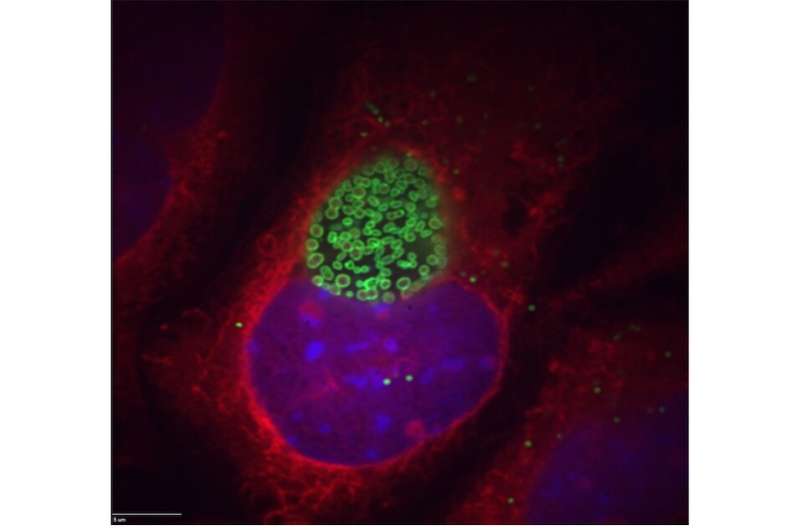How Long Does Chlamydia Take To Show Up

Co-ordinate to the Centers for Disease Control and Prevention, chlamydia trachomatis is the almost unremarkably reported sexually transmitted bacterial affliction in the U.S., totaling 1.vii meg cases in 2017. Rates are highest among teenagers and immature adults. Left untreated, chlamydia can cause blindness and sterility. Beyond the U.S., chlamydia is the leading sexually transmitted bacterial infection worldwide.
A recent paper by a team of molecular biologists headquartered at the University of Kansas pinpointed a factor that allows chlamydia to take up DNA from its host environs.
"Right at present, the main antibiotics to treat chlamydia are doxycycline and azithromycin, but these are similar to what you'd take for back acne or a respiratory infection, respectively," said pb writer Scott LaBrie, a doctoral student in the Section of Molecular Biosciences at KU. "Those drugs not simply touch on chlamydia, but they besides affect lots of other microbes, including your microbiome. So, while there are sufficient drugs out there to eliminate your chlamydia infection, you're also potentially disrupting your natural flora. Developing a therapeutic that tin be specific to chlamydia is of pretty large importance. We're learning more and more than that homeostasis of your gut, of your body's microflora, that's important for health."
LaBrie's collaborators in the research presented in mBio were KU graduate students Zoë Dimond, Kelly Harrison, Srishti Baid, postdoctoral scientist Jason Wickstrum, and with P. Scott Hefty, professor of molecular biosciences. The KU researchers from the Hefty Lab also worked with co-author Robert Suchland of the University of Washington.
"In order to cause disease, chlamydia must enter a host cell and protect itself from host defenses while as well replicating in large numbers then that it tin can spread to surrounding cells," corresponding author Hefty said. "The mechanisms that many bacteria apply to cause disease are oftentimes acquired by sharing and taking in new DNA, the molecule that makes upwards an organism'due south genes. Until at present, it has not been well understood how chlamydia acquires new DNA. However, using a novel genetic tool, this newspaper identified a cistron that allows chlamydia to obtain new DNA from its surrounding environment."
The enquiry team used a genetic tool called "transposon mutagenesis" that generates a mutation in a single factor. The researchers disrupted more than 80 genes in the chlamydia bacterium's chromosome, so observed effects on growth and infection.
"There's roughly 1,000 genes that tin can potentially be disrupted," LaBrie said. "There oasis't been very many genetic tools developed to investigate the basic biology of chlamydia. So, this allows us to randomly disrupt individual genes—and so investigate what the outcome is or the phenotype. That tin then highlight the importance of that cistron and the role that it might play in the organism'south ability to cause disease."
LaBrie compared testing the functionality of chlamydia at the molecular level to experiments on a military vehicle.
"That's where this tool comes in," he said. "I kind of equate information technology to a military Humvee. If you had no idea what that vehicle was for, you might be able to kick out its headlights. And so you would observe it only travels during the daytime, not at dark. If you pop the tire, information technology might non go anywhere. Then if you knocked out its gun, it might drive all over the place, just it doesn't kill anyone. That's kind of what we're doing with dissimilar pieces of Chlamydia—we're knocking out unlike specific components, and and so observing how that affects its power to either replicate, or infect and get into the host cell, or how well information technology does in infecting the host overall."
Using this process-of-emptying both in petri dishes and mouse models, the team isolated one disquisitional cistron in chlamydia that encodes a protein that acquires new Dna from its host environs, named "ct339."
"The mutation in this gene provided the opportunity to generate evidence that without the intact gene, chlamydia could no longer learn new genetic material that assists with accommodation to its environment, including host defenses," Hefty said.
LaBrie called the research "foundational brickwork."
"We hope this tool tin can highlight different genes and their products, which so could be targeted for therapeutics," he said. "Information technology might exist that within this library of mutants at that place would exist something that could come out as an absolute machinery used for virulence that could exist then targeted—either past some drug that could bind and inhibit that protein from conveying out its function, or by identifying something that's on the surface that tin be targeted for a vaccine. Overall, this is generally bones science, but it could help develop targets for hereafter therapeutics."
LaBrie, who hails from Sacramento, California, and attended Haskell Indian Nations University for his undergraduate studies before coming to KU, said he hoped to earn his doctorate caste next spring. After that, he plans to relocate to Alaska with his wife where he aims to continue his research career.
More information: Scott D. LaBrie et al, Transposon Mutagenesis in Chlamydia trachomatis Identifies CT339 equally a ComEC Homolog Important for Dna Uptake and Lateral Factor Transfer, mBio (2019). DOI: x.1128/mBio.01343-19
Periodical information: mBio
Citation: Researchers observe how chlamydia takes upwards new DNA from host (2019, Oct 10) retrieved 7 February 2022 from https://phys.org/news/2019-10-chlamydia-deoxyribonucleic acid-host.html
This certificate is subject to copyright. Apart from any fair dealing for the purpose of individual report or research, no part may exist reproduced without the written permission. The content is provided for information purposes only.
Source: https://phys.org/news/2019-10-chlamydia-dna-host.html
Posted by: rhodesentenight.blogspot.com


0 Response to "How Long Does Chlamydia Take To Show Up"
Post a Comment